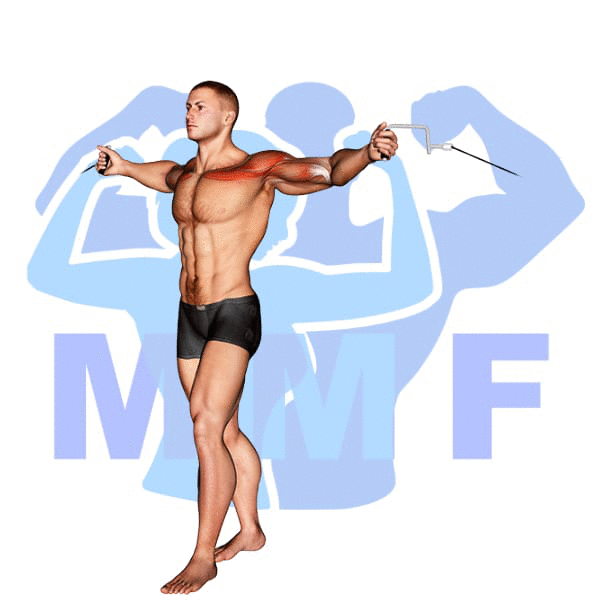Are you struggling to properly execute a stability ball dumbbell fly? Don’t worry, you’re not alone. It’s common for beginners and even some experienced gym-goers to struggle with this exercise. The instability of the ball combined with the added weight of dumbbells can make it difficult to maintain balance and control. But, there’s a reason why this exercise has been gaining popularity in recent years – it’s an effective way to build chest and shoulder strength while also engaging your core. In this post, we’ll break down the stability ball dumbbell fly step by step, so you can perfect your form and get the most out of this exercise.
Stability Ball Dumbbell Fly Summary
- Primary Muscles: Pectoralis Major – Sternal
- Secondary Muscles: Latissimus Dorsi, Levator Scapulae, Pectoralis Major – Clavicular, Pectoralis Minor, and Rhomboids
- Equipment: Dumbbells and Stability Ball
- Mechanics Type: Isolation
- Force: Push
- Utility: Auxiliary
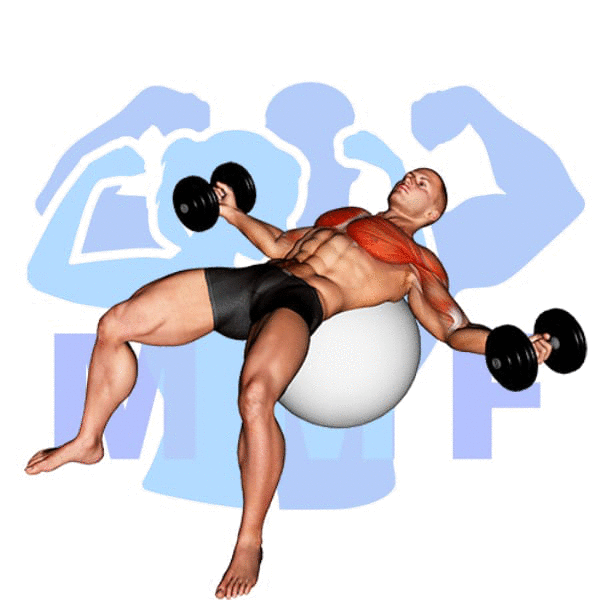
Stability Ball Dumbbell Fly Instructions
- You may start by taking your dumbbells and having a seat on a stability ball.
- Roll forward on the stability ball until your back is flat on the ball.
- Begin your flys with your arm spread wide palms facing up, then pull your arms and dumbbells together without bending your elbows.
- After the dumbbells have come together at the top, lower them back down to the starting position.
- Do it again to executed your preferred repetitions.
Video Tutorial
Stability Ball Dumbbell Fly Muscles
Target (Agonist)
- Pectoralis Major, Sternal
Synergists
- Latissimus Dorsi
- Levator Scapulae
- Pectoralis Major – Clavicular
- Pectoralis Minor
- Rhomboids
Dynamic Stabilizers
- None
Stabilizers
Antagonist Stabilizers

Benefits of Stability Ball Dumbbell Fly
The Stability Ball Dumbbell Fly is an effective exercise for strengthening the pectoralis major – sternal muscle. This exercise targets the muscle group, allowing you to build strength, stability and mobility. Not only does this exercise help to improve upper body strength and stability, but it can also improve posture and core strength. Performing this exercise regularly will help to tone and define the chest area, and will help to improve overall balance and coordination. Furthermore, it is an excellent exercise for relieving shoulder pain, as it helps to stretch and strengthen the muscles in the shoulder area. Overall, the Stability Ball Dumbbell Fly is a great exercise for anyone looking to improve their strength and fitness routine.
Tips for Performing Stability Ball Dumbbell Fly
Should you desire to develop the optimal strength gains, you must take advantage of these timeless tips. Similarly, whenever you would like to reduce the likelihood of having an injury, you should stick with these tips.
- Always Keep Your Abs Tight. For most exercises, you will need to reinforce your back bone by flexing your core to strengthen your inner pressure all around your spinal column.
- Prepare the weight that will permit for a maximum range of motion.
- Do Drop Sets. You can boost your muscle development through drop sets. Drop sets are any time you do a set to near failure after that you drop the weight and continue. You are able to reduce the weight numerous times.
- Always Keep Your Abs Flexed. For most exercises, you will need to help support your back bone by flexing your core to strengthen your inner pressure near your backbone.
Benefits and Tips Video
Frequent Mistakes To Avoid
You will need to keep from making these typical errors to support nice form and muscle growth. At the same time, when you avoid these issues you will lessen the odds of having injuries.
- You Can’t Make It To Easy. The only way to improve strength will be to challenge yourself.
- Don’t Relax Your Stomach. Keeping your core tight to protect your spinal column by maintaining your internal pressure.
- Stop Trying To begin using improper technique. Poor technique might be a rapid path to experience an injury.
Find More Dumbbell Exercises Here
Variations and Complementary Exercises
It is important to vary your workout routine and to add different exercises that work the same muscles as the Stability Ball Dumbbell Fly. Below are some variations, complementary, and alternative exercises that you can use to mix up your workout routine and to keep challenging your muscles.
Stability Ball Incline Dumbbell Fly

Stability Ball Incline Dumbbell Fly is a great complementary exercise to Stability Ball Dumbbell Fly. This exercise works the same muscles as the original exercise, but it adds an extra challenge by forcing you to work against gravity. By performing the exercise on an incline, you are working against gravity and increasing the intensity of the exercise. The incline also works your core muscles, helping you to build stability and balance. Stability Ball Incline Dumbbell Fly is a great alternative exercise for those who are looking for a more challenging version of the classic Stability Ball Dumbbell Fly.
Cable Crossover Flys
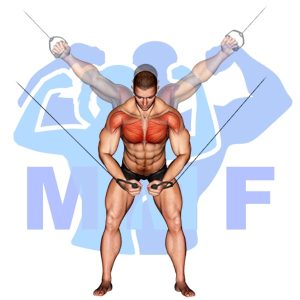
Cable Crossover Flys are an excellent complementary or alternative exercise for Stability Ball Dumbbell Flys. This exercise allows the user to engage multiple muscles at once, including the chest, shoulders, and arms. Using a cable machine, the user stands with their feet shoulder-width apart and arms slightly bent at the elbow. The user then pulls the cable handles together, bringing them close to the center of their body. This exercise engages the entire chest and shoulder muscles, as well as the arms, and is great for building strength in these areas. By using a cable machine for this exercise, you can also control the weight and adjust it to best suit your needs.
Cable Decline Fly
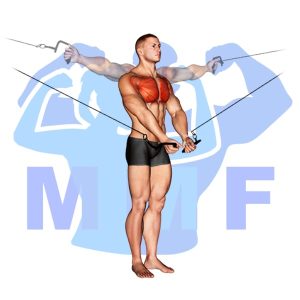
The Cable Decline Fly is an excellent exercise for targeting the chest muscles, and can be used as either a complementary or alternative exercise for the Stability Ball Dumbbell Fly. The Cable Decline Fly involves a cable machine set at a low level, with handles attached to the pulleys. The user stands in a decline position and pulls the handles towards each other, making sure to keep the arms straight throughout the movement. This exercise requires more control and stability than the Stability Ball Dumbbell Fly, as the cable tension provides constant resistance throughout the entire range of motion. Furthermore, this exercise also allows for greater weight loading than the Stability Ball Dumbbell Fly, making it ideal for muscle building.
Check Out These Top Dumbbell Exercises
Cable Flys

Cable Flys are a great complementary or alternative exercise to the Stability Ball Dumbbell Fly. This exercise works the same muscles but with the added benefit of providing more stability. The cable fly requires the user to stand between two cables set at shoulder height and then pull the cables outwards, bringing them together at the chest level. This exercise also provides a greater range of motion than the stability ball dumbbell fly, making it more effective for targeting the chest muscles. The cable fly can be done with different weight levels, allowing users to increase intensity as they progress.
Cable Low Fly

Cable Low Fly is a great alternative or complementary exercise for Stability Ball Dumbbell Fly. This exercise requires the user to stand in a split stance with one foot forward and one foot behind, holding a cable handle with both hands in front of them. The user then pulls the cable handle in towards their chest, keeping their core engaged and their arms straight. Cable Low Fly is an effective exercise to target the chest, shoulders and arms, and can provide a different range of motion than that of the Stability Ball Dumbbell Fly. Additionally, it offers more control and stability, making it easier for beginners to perform the exercise with proper form.
Decline Dumbbell Fly
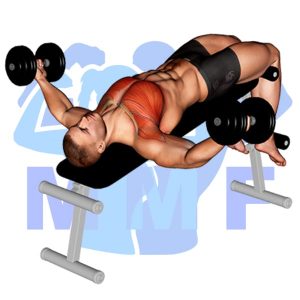
The Decline Dumbbell Fly is a great complementary exercise or alternative to the Stability Ball Dumbbell Fly. This exercise focuses on the chest muscles and works them in a different way than the Stability Ball Dumbbell Fly. It also helps to increase stability, as it is performed on a decline bench. To perform this exercise, you lie on the decline bench with your feet firmly placed and hold a dumbbell in each hand. Then, keeping your elbows slightly bent, you lower the dumbbells out to the sides until they are in line with your shoulders and then bring them back up to the starting position. This exercise is an excellent way to target the chest muscles for increased strength and stability.
Find More Chest Exercises Here
Opposing Complementary Exercises
It is important to complement any workout with exercises that use opposing muscle groups. Doing so helps to create balance in the body and prevents muscle imbalances. The following exercises are designed to work the opposite muscles as the exercise Stability Ball Dumbbell Fly.
Dumbbell Rear Deltoid Raise

The Dumbbell Rear Deltoid Raise is a great exercise for strengthening the posterior shoulder muscles. This exercise is complementary to the Stability Ball Dumbbell Fly, as it works the opposing muscle group. The Stability Ball Dumbbell Fly focuses on strengthening the anterior shoulder muscles, while the Dumbbell Rear Deltoid Raise works the posterior shoulder muscles. Both exercises will help to improve shoulder strength and stability, and can be performed together for a complete shoulder workout.
Incline Dumbbell Rear Deltoid Row

The incline dumbbell rear deltoid row is a great exercise to pair with the stability ball dumbbell fly, as it works the opposite muscle group. This exercise targets the rear deltoids, which are used in pulling movements. The incline allows for a greater range of motion and increased tension on the muscles. By alternating between this exercise and the stability ball dumbbell fly, you will be able to strengthen both the pushing and pulling muscles of the shoulder, thus creating a balanced and strong upper body.
Lever High Row (Machine)

The Lever High Row is an excellent complement to the Stability Ball Dumbbell Fly. It is a machine-based exercise that uses the opposing muscle group to the one used in the Stability Ball Dumbbell Fly. The Lever High Row works the back muscles, which are the antagonists to the chest muscles used in the Stability Ball Dumbbell Fly. This creates balance and helps to prevent injury. Additionally, the Lever High Row can be used to target different areas of the back, such as the lats, traps, and rear deltoids. By incorporating both exercises into a workout routine, you can build strength and stability throughout the upper body.
Strengthen Your Chest with Stability Ball Dumbbell Flys
The chest muscles are a crucial part of the upper body and are often targeted during workouts. One effective way to strengthen your chest muscles is by performing stability ball dumbbell fly exercises. These exercises require a stability ball and dumbbells, and help to build mass and definition in the chest. By placing your feet on the ground and using the stability ball to support your upper back, you can safely perform a range of fly exercises that target different areas of the chest. Incorporating stability ball dumbbell flys into your workout routine can help you achieve your fitness goals and improve your overall upper body strength.
References: Wikipedia | ExRx.net | PubMed.gov | Comprehensive List of Chest Dumbbell Exercises


